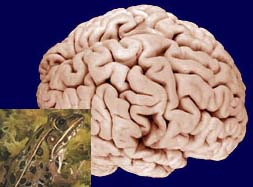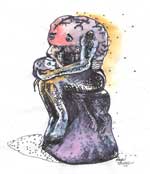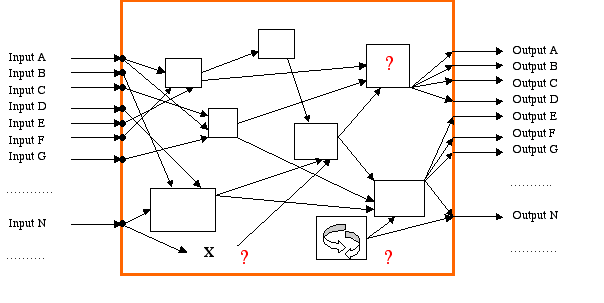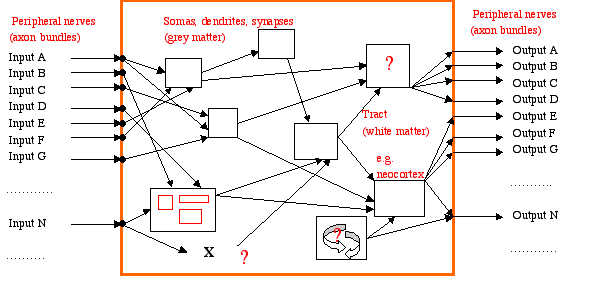Serendip is an independent site partnering with faculty at multiple colleges and universities around the world. Happy exploring!
BBI 2007 Session 5


|
BRAIN AND BEHAVIOR INSTITUTE 2007 |

|
Neurons and Nervous System Architecture:
Autonomy, Variability, Feedback, and Exploration
Review (and completion)
- Emily Dickinson
- "I also thought Emily Dickenson provided a wonderful "summary of osbservations" for future generations to test. Who knew she was a brilliant scientist in addition to an eloquent poet!" ... Mingh
- "We really are brain surgeons, and the scary thing is that I think many educators out there are unaware of that fact or unwilling to consider such a story or explanation from that perspective." ... Graham
- Outputs without inputs
 |
Helps with
|
Beginning to get some answers to new questions
 |
|
The Signals
- Action potentials (more this afternoon), receptor potentials, synaptic potentials
- Takes time
- Importance of inhibition as well as excitation
- Chemical sensitivity
- Equivilence of signals in all cables, problem of interpretation



Comments
Brain matters
neurons
Action Potentials
The Nervous System
neurons
Brain surgeons and action potentials
I will reflect on connecting yesterday’s comment concerning teachers being brain surgeons and this morning presentation on action potentials of students’ sensory neurons.
Now that I know that all neurons’ action potentials have a threshold for action, which it is all or nothing, I must consider the sensory inputs that students in my class are receiving from me in my classroom. Am I giving enough sensory input to penetrate “the feeble dullness in the eyes” of the average child? Why I am not overcoming the minimal action potentials necessary for activation? What can I, as a skilled brain surgeon, do to alter the sensory inputs, which are obviously not being effective processed by the bored or acting out child? Is the bored or acting child behaving due to the sensory inputs s/he is receiving from me or is it a situation beyond my control that is causing this behavior? Should I shift my delivery to include others senses? What should a skilled brain surgeon do?
Okay so now we know we have
neurons
neurons
session 5
neurons
Wednesday - morning/afternoon session
On the tips of our toes
What we are learning today really demonstrates how complicated the process of generating and repressing signals is. Some inputs produce an output, others produce none and still other outputs are generated with no inputs at all.
What will become important now is to understand how the brain remembers materials that we have learned and employs them for recall. If we understand how and where our students are processing the information, and, more specifically, what their nervous systems are doing with the stories we provide them (or expect them to remember, at any rate), we may better understand how to more efficiently and effectively reach our students.
Also for myself, it will prove interesting as I try to understand the connection between my nervous system and my body and how that helps me to remember movement. This in turn will (I hope) help me to become a better dancer...
Neurons Reflection
neurons
neurons and more
I thought Paul did a great job of making the complex neurological system understandable to those of us who have not dedicated our lives to studying it. The technique used exemplifies the qualities of a great teacher that really cares about distributing knowledge. He really knows his material, and then uses a variety of methods and common examples to illustrate points. This shows an awareness about our learning in different ways, and a willingness to take that into account during instruction. From what I've learned about the brain today, his teaching style must be related to what he knows about brain functioning. I'm excited at the prospect of learning more about the brain. I think it will help give me a deeper understanding about my students, which will only enhance my ability to teach them.
I like how Peter was unwilling to elaborate on specifics that he did not feel he was an expert on. It somehow coaborated Paul's idea about getting our stories "less wrong". It also caused me to reflect about assumptions I make while teaching. When I think a child is "shutting down", is that something he or she is purposfully doing? Is it a case of leaky neurons or the processing speed of the central nervous system? Can I alter my way of transmitting information to help? Does part of my job involve helping children with metacognition-to give them more control over these things? This discussion about the brain is helping me find my way to those answers, and allowing me to create my own teaching story.
Post new comment